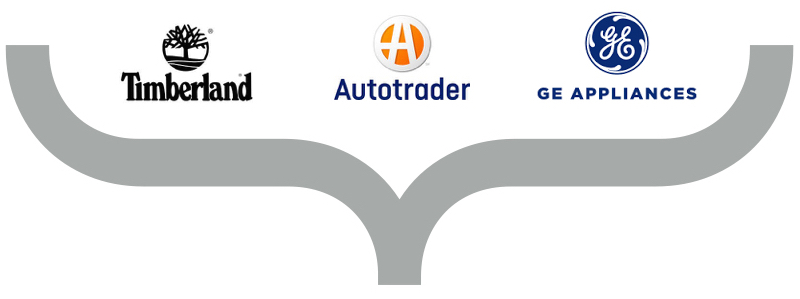

The future of co-op advertising hangs in the balance; it hasn’t seen innovation for decades. Is co-op walking dead? That’s one of the questions we posed to three seasoned retail marketers.
Amidst the digital revolution, co-op advertising has stayed the same. To better understand challenges to innovation, Ben Carcio (Co-Founder and CEO, Promoboxx) interviews Cassie Heppner (Timberland), Alpesh Patel (AutoTrader), and Leslie Hagan (GE Appliances). Here’s what our digital marketing experts have to say about co-op advertising:
Cassie [Timberland]: “While we advertise on a brand level, a national level, and even a regional level, we’ve really looked to the retail partners to drive things home and connect with the consumer.”
Timberland’s approach to co-op advertising focuses on controlling how the dollars are allocated on a retailer-by-retailer basis. The stores that showcase the brand in the best possible light get more co-op. As a means of incentivizing the retailers to improve in-store marketing and meet requirements for increased co-op dollars, Timberland offers things like fixture programs at no cost. On the digital side, assets are co-branded and promoted through Promoboxx. Cassie’s team works hard to get its products out in front of retailers in a way that fits with the brand story.
Leslie [GE]: “Traditional co-op: it works, but it’s not flawless.”
GE Appliances’ more traditional co-op program helps offset advertising costs after retailer marketing dollars have been spent. GE isn’t afraid to highlight program flaws. Leslie’s team is actively looking for ways to enhance the current co-op offering to help improve the experience for both brand and retailer. Ultimately, GE is looking to position itself as a collaborator / consultant — running marketing efforts alongside retailers and helping them make sense of all of the data to achieve common goals.
Alpesh [AutoTrader]: “Effectiveness is the key.”
Juggling so many different brands, manufacturers, and dealers, Alpesh works to keep the company aligned with countless guidelines and regulations to ensure dollars are flowing and dealers are compliant. The effectiveness of the program suffers as dealers try to go it alone — opting for the easiest advertising methods on outdated channels. AutoTrader’s attempts to talk about digital opportunities that are also compliant with co-op guidelines highlights the ineffectiveness of co-op.
Leslie [GE]: “I don’t think it’s for lack of acumen, so much as it’s just so new, as well as the speed in which it’s changing.”
Cassie [Timberland]: “I think as this next generation comes up, the digital space is going to absolutely bloom for us all and our retailers and we’ll all be at the forefront of helping our retail partners move forward.”
Many independent retailers are father/son, mother/daughter teams built upon generations of family. The younger marketers get digital, and they’re being handed the reins. Technology is evolving so quickly that if you didn’t grow up with it, keeping abreast is difficult. Luckily, brands are here to support all retailers in becoming better business people. Co-op needs to be a part of that helping hand.
Alpesh [AutoTrader]: “Retailers are looking back to their brands and saying, ‘Hey, can you help us identify and leverage the right guidelines and tools?’”
Today, retailers are being handed so many different organic and paid platform options, leading them to ask more fervently for help from brands to stay within co-op guidelines. One model in the automotive space (noted by Alpesh) allows dealers to pick and choose their guidelines, but with a guiding hand from the brand based on their needs. Other brands opt for a more forced digital strategy, taking control from the dealers to make sure that things are aligned and standardized. The problem with this approach is that it leaves the retailer in the dark thus making for a very disconnected digital to in-store consumer experience.
Leslie [GE]: “Yes. One of the key elements is planning.”
Cassie [Timberland]: “Yes and we’re asking ourselves what key initiatives do we want to get behind.”
For Leslie, one of her team’s biggest wins has come from maintaining a co-op allocation schedule and (in doing so) taking the heavy lifting off of the retailers. She explains that it all comes down to collaboration. By planning with retailers months or even a year in advance, they’ll know what their co-op dollars are and can create a strategy to spend it. This ultimately helps GE understand what channels retailers need assistance with in an effort to encourage them to try new things.
For Cassie, the focus is on strategic initiatives. Timberland promotes key initiatives to retail accounts via incentives. When retailers agree to support a program, they receive everything they need — the ultimate marketing and advertising toolkit.
Cassie [Timberland]: “We’re flexible and do give our retailers as much support as they need. Some are willing to relinquish power for some kind of help with their marketing and others want the freedom to execute on their own. Either way, no problem.”
Leslie [GE]: “Stay patient and take whatever time is needed. Collaboration may not be moving as quickly as you’d like, but what’s important is that it continues to press forward.”
Alpesh [AutoTrader]: “By helping to get retailers around the hassle of co-op advertising.” [Smiles.]
Everyone agrees that co-op advertising must be streamlined. As Leslie said, “Technology is key.” One way to do so, as Cassie pointed out, would be to “programmatically reward retailers for following best practices and standards with incentives.”
The real takeaway? Co-op advertising as we know it must be redefined.

